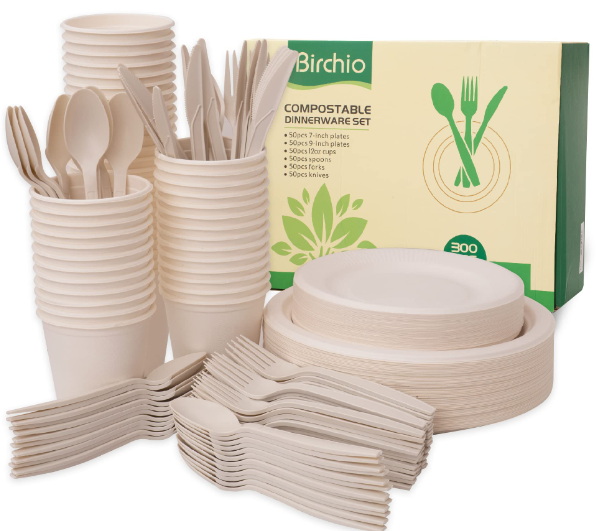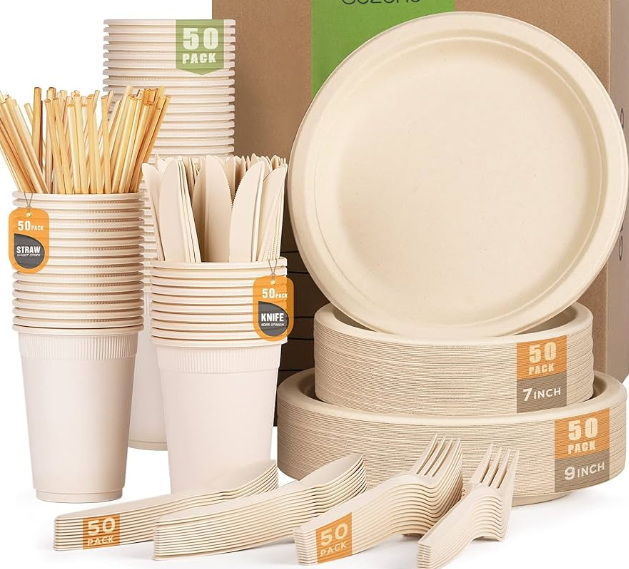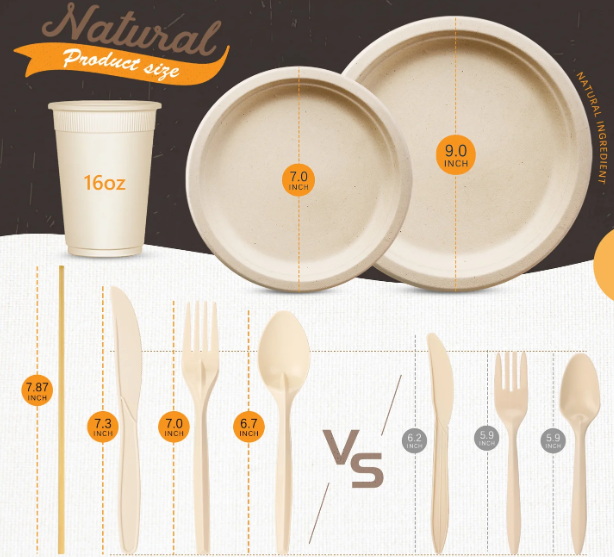
Content Menu
● Introduction to Disposable Tableware
>> Traditional Disposable Materials
● Eco-Friendly Alternatives
>> 1. Bamboo Plates
>> 2. Sugarcane Bagasse Plates
>> 3. Palm Leaf Plates
>> 4. Cornstarch-Based Tableware
>> 5. PLA (Polylactic Acid) Tableware
● Environmental Impact
>> Comparison of Environmental Impacts
>> Reducing Plastic Pollution
● Health Benefits
● Sustainable Practices
● Cost-Effectiveness
● Conclusion
● Frequently Asked Questions
>> 1. What are the most eco-friendly materials for disposable plates and spoons?
>> 2. How long do eco-friendly disposable plates take to decompose?
>> 3. Are eco-friendly disposable plates more expensive than traditional options?
>> 4. Can eco-friendly disposable plates be reused?
>> 5. How can I dispose of eco-friendly disposable plates and spoons?
● Citations:
In recent years, the environmental impact of disposable tableware has become a significant concern. Traditional disposable plates and spoons, often made from plastic, contribute to pollution and waste management issues. However, eco-friendly alternatives are emerging, offering a more sustainable option for consumers. This article explores the eco-friendliness of disposable plate and spoon sets, focusing on materials, environmental impact, and sustainable alternatives.

Introduction to Disposable Tableware
Disposable tableware, including plates and spoons, has been a staple in modern convenience due to its ease of use and minimal cleanup requirements. However, the environmental consequences of traditional disposable items are substantial. Plastic plates and utensils take centuries to decompose, releasing harmful chemicals into the environment and contributing to plastic pollution in oceans and landfills.
Traditional Disposable Materials
1. Plastic Plates and Utensils: Made from fossil fuels, these items are non-biodegradable and contribute significantly to greenhouse gas emissions during production. They break down into microplastics, which can harm wildlife and contaminate the food chain.
2. Paper Plates: While biodegradable, paper plates often require unsustainable forestry practices and large amounts of water for production. Coated paper plates lose their compostability due to chemical treatments.
Eco-Friendly Alternatives
Eco-friendly disposable plate and spoon sets are made from sustainable materials that are biodegradable and compostable. These alternatives include:
1. Bamboo Plates
Bamboo is a highly renewable resource, and bamboo plates are both durable and compostable. They are made from FSC-certified bamboo, ensuring a sustainable production process. Bamboo plates can be used multiple times before composting and break down into nutrient-rich soil within months.
Bamboo is known for its rapid growth rate and requires less water than many other crops, making it an efficient choice for sustainable production. Additionally, bamboo plates are resistant to heat and moisture, making them suitable for both hot and cold foods[4].
2. Sugarcane Bagasse Plates
Sugarcane bagasse plates are made from the byproduct of sugar cane processing, reducing waste and utilizing a renewable resource. These plates are biodegradable, compostable, and free from toxins, making them a healthier option for consumers.
Sugarcane bagasse is a versatile material that can be molded into various shapes and sizes, making it ideal for different types of events and meals. It is also microwave-safe, allowing for convenient reheating of food[5].
3. Palm Leaf Plates
Palm leaf plates are sturdy, compostable, and made from naturally fallen palm leaves. They are free from chemicals and bonding agents, making them suitable for composting.
Palm leaf plates are durable and can withstand heat and moisture without becoming soggy. They are often used for serving appetizers, salads, or desserts at special occasions due to their elegant appearance[5].
4. Cornstarch-Based Tableware
Cornstarch-based tableware is made by processing corn into a biodegradable material. It is a natural alternative to synthetic plastics and is fully biodegradable and compostable under certain conditions.
Cornstarch products are non-toxic and safe for food contact, making them a healthier option compared to traditional plastics. However, they have limited durability and are not suitable for high-heat applications[2].
5. PLA (Polylactic Acid) Tableware
PLA is a biodegradable plastic made from renewable resources such as corn starch or sugarcane. It is compostable and offers a more sustainable alternative to traditional plastics.
PLA tableware is lightweight and can be molded into various shapes. It is suitable for cold foods but may not be as durable as other eco-friendly options[2].

Environmental Impact
The environmental impact of disposable tableware depends on the materials used and how they are disposed of. Eco-friendly options significantly reduce waste and pollution by decomposing naturally and returning nutrients to the soil.
Comparison of Environmental Impacts
| Material | Biodegradability | Renewable Resource | Environmental Impact |
| Plastic | Non-biodegradable | Non-renewable | High pollution risk |
| Paper | Biodegradable | Renewable, but unsustainable practices | Moderate impact |
| Bamboo | Compostable | Highly renewable | Low impact |
| Sugarcane Bagasse | Compostable | Renewable | Low impact |
| Palm Leaf | Compostable | Renewable | Low impact |
| Cornstarch | Biodegradable | Renewable | Low impact |
Reducing Plastic Pollution
Traditional plastic tableware contributes significantly to ocean pollution, with millions of tons of plastic waste entering marine ecosystems annually. Eco-friendly alternatives help reduce this pollution by decomposing quickly and naturally[1][6].
Health Benefits
Eco-friendly disposable plate and spoon sets are not only better for the environment but also safer for consumers. Unlike plastic, which can leach harmful chemicals like BPA into food, eco-friendly materials are toxin-free.
Sustainable Practices
Choosing eco-friendly disposable tableware supports sustainable practices and businesses committed to minimizing their environmental impact. This choice also enhances a company's brand image and reputation among environmentally conscious consumers[7].
Cost-Effectiveness
While eco-friendly disposable tableware may have a slightly higher upfront cost than traditional options, it offers long-term benefits. These products can be composted and used as fertilizer, reducing waste disposal costs and supporting sustainable agriculture[7].
Conclusion
Disposable plate and spoon sets can be eco-friendly if made from sustainable materials like bamboo, sugarcane bagasse, or palm leaves. These alternatives offer a convenient and environmentally responsible choice for consumers. By choosing compostable and biodegradable options, we can reduce plastic waste and support sustainable practices.

Frequently Asked Questions
1. What are the most eco-friendly materials for disposable plates and spoons?
The most eco-friendly materials for disposable plates and spoons include bamboo, sugarcane bagasse, and palm leaves. These materials are biodegradable, compostable, and made from renewable resources.
2. How long do eco-friendly disposable plates take to decompose?
Eco-friendly disposable plates made from materials like bamboo, sugarcane bagasse, or palm leaves typically decompose within a few months in a composting environment. This process enriches the soil without leaving harmful residues.
3. Are eco-friendly disposable plates more expensive than traditional options?
While eco-friendly disposable plates may have a slightly higher upfront cost than traditional plastic or paper plates, they offer significant long-term environmental benefits. Many consumers find these benefits well worth the investment.
4. Can eco-friendly disposable plates be reused?
Some eco-friendly disposable plates, like those made from palm leaves, can be reused if used for dry foods and cleaned properly. However, they are generally designed for single use.
5. How can I dispose of eco-friendly disposable plates and spoons?
Eco-friendly disposable plates and spoons should be composted whenever possible to ensure they break down into nutrient-rich soil. If composting facilities are not available, they can be disposed of with yard waste.
Citations:
[1] https://www.green-sapling.com/blogs/news/biodegradable-dinnerware-are-amazing-9-reasons-why
[2] https://www.bioleaderpack.com/8-different-kinds-of-materials-used-in-eco-friendly-disposable-tableware/
[3] https://foliumware.com/the-environmental-impact-of-disposable-tableware-a-comprehensive-guide/
[4] https://www.bambuhome.com/blogs/bambuliving/compostable-vs-disposable-plates
[5] https://palmware.in/ultimate-guide-to-eco-friendly-disposable-tableware/
[6] https://www.quitplastic.in/post/the-environmental-impact-of-traditional-disposable-tableware
[7] https://www.anchenggy.com/blog/benefits-of-using-eco-friendly-disposable-utensils.html
[8] https://directecogreen.com/food-packaging/single-use-disposable-tableware/
[9] https://www.lifecycleinitiative.org/wp-content/uploads/2021/03/UNEP-D001-Tableware-Report_Lowres.pdf
[10] https://www.green-sapling.com/blogs/news/the-benefits-of-utilizing-eco-friendly-disposable-tableware-at-parties
[11] https://greentableware.hk/en-us/home/about
[12] https://www.epd.gov.hk/epd/sites/default/files/epd/english/environmentinhk/waste/pub_consult/files/tableware-con-doc-en.pdf
[13] https://www.ecobifrost.com/advantages-of-eco-friendly-disposable-bamboo-cutlery-sets/
[14] https://www.anchenggy.com/blog/best-disposable-plastic-cutlery-alternatives.html
[15] https://www.greenpower.org.hk/eng-all-about-greens/calling-for-comprehensive-regulation-of-disposable-plastic-tableware
[16] https://greenpaperproducts.com/blog/the-importance-of-eco-friendly-disposable-tableware-for-food-businesses
[17] https://ch.duni.com/it/magazin/verpackungen/bagasse-nachhaltiges-material-fur-einweggeschirr
[18] https://cmjjgourmet.com/blog/best-disposable-tableware/
[19] https://www.researchgate.net/publication/371665738_Biodegradable_Ecofriendly_Sustainable_Tableware_and_Packaging_A_Comprehensive_Review_of_Materials_Manufacturing_and_Applications
[20] https://www.enviropack.org.uk/tableware/plates

















